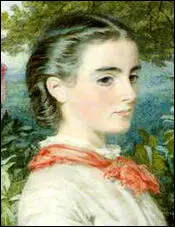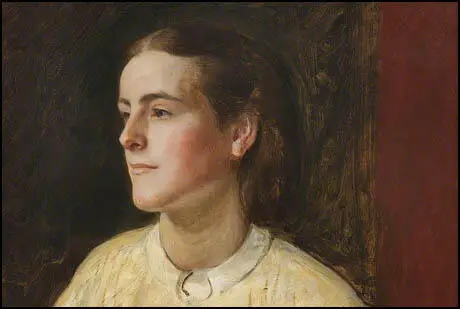Clara Mordan

Clara Mordan, the daughter of a prosperous manufacturer of propelling pencils, was born in South Kensington South Kensington on 28th September 1844. She became a supporter of women's suffrage after hearing John Stuart Mill make a speech on the subject in 1866. Mordan attended several public meetings on the enfranchisement of women before joining the Manchester National Society for Women's Suffrage in 1888. In 1900 Clara Mordan became a member of the executive committee of the Central Society for Women's Suffrage. Her father died in 1901, leaving an estate that was worth £117,864.
Mordan had been a loyal supporter of the policies of the National Union of Suffrage Societies but in 1906, after hearing a speech by Annie Kenney, she joined the Women's Social and Political Union (WSPU). She later told Mary Blathwayt that she was convinced by "the beautiful and simple way in which Annie Kenney laid the case before her."
In her autobiography, Memories of a Militant (1924), Annie Kenney confirms that "Miss Mordan attended the first WSPU meeting held in Caxton Hall... and afterwards sent £20 towards expenses... I went to see her and she became one of our most loyal members and most generous subscribers."
According to Elizabeth Crawford, the author of The Suffragette Movement (1999): "By February 1907 Clara Mordan had given at least £172 to the WSPU; in July 1907 she gave a further £10; in 1908-09 a total of £577; in April 1909 a further £100 to be towards the cost of the Prince's Rink Exhibition; £60 in October 1909, and a further £100 in December, specifically for the General Election Fund, a further £100 in March 1910, and £200 in June 1912 to support the renewal of militancy."
Mordan also made several speeches on behalf of the WSPU. This included public meetings in Bristol and Plymouth in 1908. On 14th January 1909 Mordan presented Emmeline Pankhurst with an amethyst, pearl and emerald necklace on her release from prison.

Mordan stayed at Eagle House at Batheaston, the home of Mary Blathwayt. Others who spent time at Blathwayt's house included Christabel Pankhurst, Jessie Kenney, Annie Kenney, Clara Codd, Helen Watts, Elsie Howey, Constance Lytton and Vera Wentworth. Colonel Blathwayt photographed the women. These were then signed and sold at WSPU bazaars. He also invited them to plant a tree to commemorate their prison sentences and hunger strikes.
Clara Mordan was suffering from tuberculosis and was unable to do anything that meant she was sent to prison. On 21st October 1910 she had a letter published in Votes for Women in which she wrote that "I have impressed upon my doctor that she really must keep me alive till I can have a reasonable prospect of feeling that my last bed will be a coffin some woman has earned her living by making."
Other organisations that Mordan supported included New Constitutional Society, Tax Resistance League, National Political League and the Church League for Women's Suffrage. She also contributed towards the expenses of George Lansbury when in October 1912 he resigned his seat in the House of Commons and fighting a by-election in favour of votes for women. Lansbury discovered that a large number of males were still opposed to equal rights for women and he was defeated by 731 votes.
Clara Mordan, who never married, died on 22nd January 1915 at 18 Marine Mansions, Bexhill, East Sussex. She left most of her money to the woman she lived with, Mary Gray Allen.
Primary Sources
(1) Vanessa Thorpe and Alec Marsh, The Observer (11th June 2000)
Entries in the diary of a suffragette have revealed that key members of the Votes For Women movement led a promiscuous lesbian lifestyle.
The diaries of supporter Mary Blathwayt, kept from 1908 to 1913, show how complicated sexual liaisons - involving the Pankhurst family and others at the core of the militant organisation - created rivalries that threatened discord.
"Mary, who had been something of a favourite, often wrote quite bluntly about the situation. It does sound as if she was occasionally quite jealous," said Professor Martin Pugh, an expert on the history of the movement, who came across the relevant and explicit pages in Blathwayt's little-known diary.
"This part of the diary puts the whole campaign in a truer perspective," he added. "All these women were under an enormous amount of pressure from around 1912, while the Home Secretary was trying to suppress their activities."
Pugh, of Liverpool John Moores University, said the tensions felt, both physically and psychologically, meant the activists had to find sus taining relationships within their own ranks.
Emmeline Pankhurst and her three daughters, Sylvia, Christabel and Adela, were the leading figures in the battle to win votes for women. Founding the hardline Women's Social and Political Union in 1903, Mrs Pankhurst, as she was popularly known, went to prison 15 times for her political views and had a close relationship with the lesbian composer Ethel Smyth for many years following the death of her husband Richard in 1898.
"Dame Ethel had realised early on in life that she loved women not men and was fairly bold about things. They were often in Holloway together and shared a cell," said Pugh.
Members of the union were social pariahs and the butt of music-hall jokes, but they were also criminals. Under the slogan Votes for Women and Chastity for Men, they bombed and set fire to churches and stations, threw bricks through windows, cut telegraph wires and tied themselves to railings.
"This was a period in which these women were carrying out something like guerrilla war - they felt they were engaging in battle with the Home Secretary, who was using all the tools of the state to oppress them," said Pugh, who is researching a biography of the Pankhurst family.
Christabel was the most classically beautiful of the Pankhurst daughters and was the focus of a rash of "crushes" across the movement. Pugh now believes she was briefly involved with Mary Blathwayt who, in her turn, was probably supplanted by Annie Kenney, a working-class activist from Oldham.
"Christabel was an object of desire for several suffragettes," he said. "She was a very striking woman."
Many of the short-lived sexual couplings referred to in the diary took place in the Blathwayt family's Eagle House home in Batheaston, near Bath.
Kenney's frequent visits to Eagle House, and to the family's Bristol lodgings, receive most scrutiny from Mary Blathwayt. Pugh's research shows that her name can now be linked to up to 10 other suffragettes.
"Mary writes matter-of-fact lines such as, "Annie slept with someone else again last night," or "There was someone else in Annie's bed this morning," said Pugh. "But it is all done with no moral opprobrium for the act itself. In the diary Kenney appears frequently and with different women. Almost day by day Mary says she is sleeping with someone else."
Kenney, organiser for the South West, volunteered to join the suffragettes after hearing Christabel Pankhurst speak at a rally in 1905. The two were sent to prison together that year after disrupting a public meeting and had an intimate friendship for several years until Christabel became involved with another woman, Grace Roe.
While the affairs and one-night-stands at Eagle House provoked competitive rivalries, it is also clear they held the movement together. Many of the relationships provided emotional support for members of a group isolated from the rest of society.
"Biographers, while acknowledging a small lesbian element in the movement, have all skirted around the issue," said Pugh. "For those times the matter-of-fact tone Blathwayt adopts about the affairs did surprise me."
The union suspended its militant activities to help the war effort in 1914 and women over 30 gained the vote in 1918. Equal suffrage was finally achieved in 1930.

